Black lice and flies on tomato plants indicate a pest infestation. We present the most common tomato pests and show how to combat aphids, fungus gnats and the like on tomatoes naturally.

Tomatoes are not only very popular with many gardeners, but unfortunately also with some pests. We will show you which pests commonly attack tomatoes and how you can get rid of them efficiently and naturally.
contents
-
Control tomato pests
- Aphids on tomatoes
-
Black flies on tomatoes
- Control fungus gnats on tomatoes
- Control thrips on tomatoes
- Whiteflies on tomatoes
- Spider mites on tomatoes
- tomato leaf miners
- Nematodes on tomatoes
- Preventing tomato pests: How to protect your tomatoes
Control tomato pests
A whole range of pests can attack tomatoes. This can not only weaken the plant, but also the fruits can quickly look ugly or lose quality. It is therefore important to discover the pest as quickly as possible and to determine which culprit it is.
Aphids on tomatoes
As soon as the tomato plant takes shape in early summer, the first ones are often already there aphids (Aphidoidea) to see. The insects, which are a few millimeters in size and mostly green or black in color, are mainly found on the tips of the shoots. The little pests pierce the phloem, certain pathways in the plant, and suck on the sugary plant sap. This weakens the plant, and the sucking activity and saliva of the lice often result in deformation of the leaves. Another sign that a tomato has been infested with lice is shiny spots or plaque on the leaves. This is honeydew, the sugary excretions of the aphids. Black fungi can form on these deposits, which are also easily recognizable in the case of an advanced infestation. These fungi impede photosynthesis, further weakening the plant. Ants are also interested in honeydew, which is why an increased occurrence of ants on a tomato plant can be an indication of an aphid infestation. In addition, the aphids can transmit viruses from one plant to another and thus damage the tomato plant.
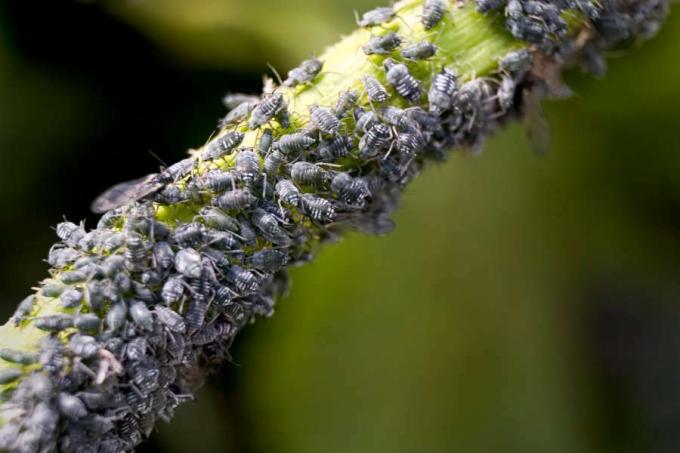
tip: Aphids multiply rapidly. The number can increase by a factor of 10 per week. If you recognize an infestation, you should act promptly to avoid mass propagation.
Control aphids on tomatoes
In the case of a slight infestation of tomatoes with aphids, home remedies can be used. Soapsuds or nettle broth are suitable for this, as we explain to you in our special article Home remedies for aphids describe in detail. If you don't want to bother using a home remedy or if the infestation is more severe, we recommend a biological pesticide. Synthetic agents are very dangerous to beneficial insects, which is why we advise you against using these agents.
Biological agents based on neem oil are particularly effective. This oil from the seeds of the neem tree allows you to get rid of aphids naturally. Our Plantura Organic Pest Free Neem based on this effective oil of the neem tree. The agent is purely herbal and can be used both outdoors and in tomato cultivation in the greenhouse. The active ingredient is absorbed by the plant and allows you to catch hidden aphids. Further damage is prevented by the suction stop that occurs quickly. At the same time is ours Organic Pest Free Neem not dangerous to bees.
To treat an area of ten square meters with tomatoes, simply mix two milliliters Organic Pest Free Neem with 600 milliliters of water. You can then spray this emulsion on the affected plants. After treating your tomatoes with organic pest-free neem, there is a waiting period of three days during which you should not harvest or eat any fruit. After this time, the active ingredient has been broken down to such an extent that you can eat the fruit with pleasure. Please use our organic pest-free neem according to the specifications in the application recommendation. Before use, you should read the package leaflet carefully.
Other biological agents based on rapeseed oil are also commercially available. Unfortunately, these have to be applied more frequently because of their lower effectiveness, which harms some plants. Another possibility is the use of beneficial insects. Ichneumon wasps, lacewings or ladybird larvae can be used against aphids. The use is particularly effective in a greenhouse or similar closed space. Please note, however, that beneficial insects cannot be used in combination with pesticides.
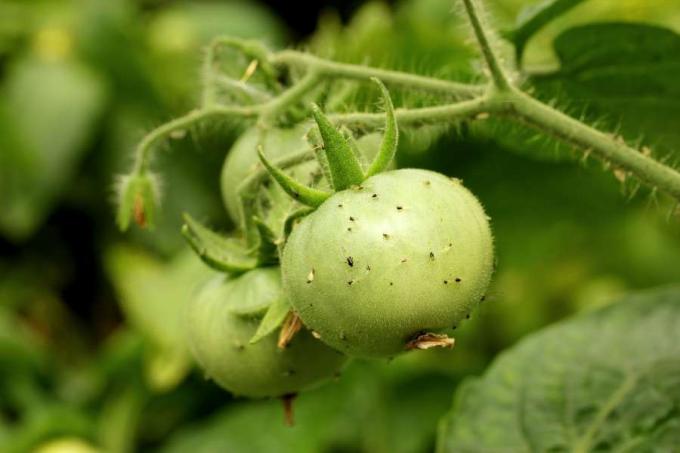
As a preventive measure, you can promote beneficial insects in your garden with a natural garden design, such as a flower meadow that is as untouched as possible. Our Plantura beneficial insect magnet is a seed mix that allows you to create such a flower meadow. When fertilizing your tomatoes, you should also ensure a good supply of potassium and reduced nitrogen fertilization. This makes your tomatoes less susceptible to aphids. We recommend special tomato fertilizers for fertilizing that are tailored to the needs of your tomatoes, such as ours Plantura organic tomato fertilizer.
More tips like you Fight aphids naturally we have compiled for you in our special article.
Summary: Combating and preventing aphids on tomatoes
- In the case of a slight infestation, household remedies such as soapy water or nettle broth are possible
- Biological pesticides like ours Plantura Organic Pest Free Neem or agents based on rapeseed oil
- Beneficial insects such as parasitic wasps and ladybird larvae, especially in protected cultivation
- Promoting beneficial insects in the garden as a preventive measure
- Make plants more resilient through need-based fertilization
Black flies on tomatoes
Do you often see small black flies on the potting soil of your tomatoes? Then it is most likely fungus gnats (Sciaridae). If small flies are only on the leaves of your tomatoes, it is certainly an infestation by thrips (Thysanoptera). Below we will show you how to combat fungus gnats or thrips on tomatoes.
Control fungus gnats on tomatoes
The best way to tell if your tomatoes are infested with fungus gnats is by the tumbling, black, adult flies flying around. In order to detect an infestation as early as possible, you can yellow boards insert. These are covered with glue and attract the fungus gnats. The insects stick to the panels and enable you to recognize an infestation early on. Yellow boards can also be used preventively, but they are not enough to combat a real infestation.
Blackfly larvae live in the potting soil, feeding on organic matter, including tomato roots. This can harm your plants and lead to wilted leaves and poor growth in the long term.
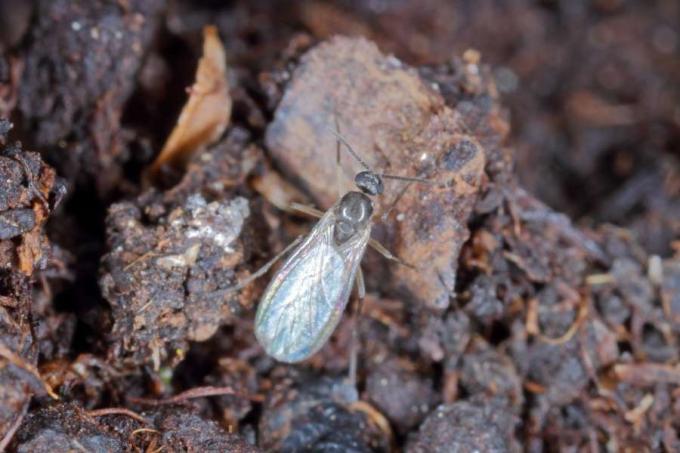
If you recognize the infestation early, you can use a home remedy. In our special article on the subject Fight fungus gnats with home remedies, we will show you how to get rid of flies with garlic, for example. In Germany, no chemical or natural spray is currently approved for treating fungus gnats on tomatoes. If the infestation is advanced or if there is no effect, we recommend that you act quickly and use beneficial insects, for example. The predatory nematodes Steinernema feltiae for example, can be used specifically against an infestation by fungus gnats. The success is visible after a few days. Another beneficial against fungus gnats is the predatory mite Macrocheles robustulus, which can be used in protected cultivation. In the case of a severe infestation, it can also be helpful to repot the plant and wash out the root ball with water. This will get rid of much of the infested soil. The plant is then repotted.
Fungus gnats only feel comfortable in permanently moist soil. As a preventive measure, we therefore recommend that you avoid waterlogging. It is also very effective to spread a 1/2 inch layer of sand, grit or expanded clay over the potting soil to keep the surface dry, which also helps preventively. This is the best way to protect all potted plants in the vicinity.

Summary: Control and prevent fungus gnats on tomatoes
- Yellow panels to identify an infestation early
- In the case of a mild infestation: use home remedies such as garlic
- No chemical or natural pesticides allowed on tomatoes
- Beneficial insects such as the predatory nematode Steinernema feltiae or the predatory mite Macrocheles robustulus work very well when used correctly
- If the infestation is severe, repot the plant and remove the old soil if possible
- To prevent this, avoid permanently moist soil and apply a thin layer of sand to the soil - this also protects other plants in the vicinity
Control thrips on tomatoes
thrips (Thysanoptera) feel particularly comfortable in low humidity and constant temperature - for example in living rooms. The insects themselves are so small that they can hardly be seen with the naked eye. An infestation can be recognized above all by the typical damage: Small yellow or silvery-grey speckles on leaves or flowers. If the infestation is more severe, these dots can become larger and the affected leaf can die off. Besides, you can blue panels place near potentially infested plants. The color of these panels attracts the thrips, which get stuck on the glue. This allows you to recognize an infestation early on.
Soapy water with olive oil or putting indoor plants out in the rain are smart home remedies that can help with a mild infestation. More on home remedies for thrips and how to use them Successful control of thrips you can find out in our special article.

Beneficial insects can also be used as a biological method. The most effective way is to use the predatory mite (Amblyseius cucumeris) or the lacewing (Chrysoperla carnea) in the greenhouse. If you are unsuccessful or if mixing a household remedy is too time-consuming for you, we recommend a biological pesticide. Neem oil-based agents are particularly effective against thrips infestation. Our Plantura Organic Pest Free Neem is also based on this highly effective oil and has already been presented above in connection with aphids.
As a preventative measure, we recommend that you ensure that the humidity in the rooms or in your greenhouse is kept stable and that it does not drop too much.
Summary: Controlling and preventing thrips on tomatoes
- In the case of a mild infestation: household remedies such as soapy water with olive oil
- Beneficial insects such as the predatory mite (Amblyseius cucumeris) or the lacewing (Chrysoperla carnea) in the greenhouse
- Organic remedies based on neem oil, like ours Plantura Organic Pest Free Neem
- Preventively prevent very low humidity
- Blue panels for early detection of infestation
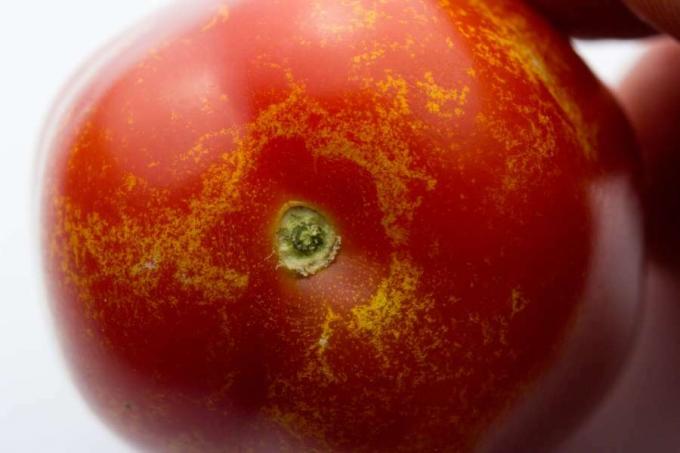
Whiteflies on tomatoes
Various genera and species of whitefly (Aleyrodoidea). Especially the cabbage whitefly (Aleurodes proletella) and the greenhouse whitefly (Trialeurodes vaporariorum) cause an annoying infestation here in Germany. This can be recognized by the small white insects on the underside of the leaf. Small white eggs, often laid in a ring, can also be discovered there. When the plant is touched, the adult insects usually fly away in a small arc.
Control whiteflies on tomatoes
A nettle decoction is particularly suitable as a home remedy for a mild infestation. You can also use potash soap and treat the plant with it. If the infestation is severe or the home remedy is not working satisfactorily, we recommend using a biological pesticide as soon as possible. Our Plantura Organic Pest Free Neem, which you have already got to know above in connection with aphids on tomatoes, can also be used effectively against whiteflies on tomatoes.
Other biological agents based on orange or rapeseed oil are also available. These agents work on contact as they block the insects' oxygen supply, causing them to die. You can also buy ready-mixed potash soap products. In addition to these biological agents, you will also find agents based on acetamiprid and deltamethrin Trade, however, both are too harmful to beneficial insects and the environment, so we do not recommend them be able.
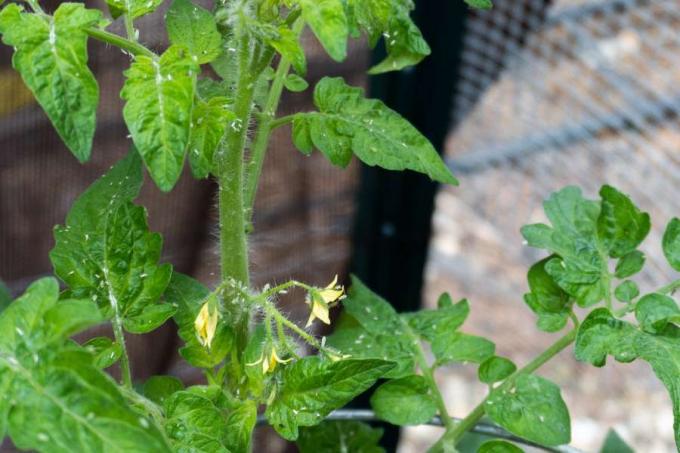
Another possibility are beneficial insects that can be used against the whitefly. These include different types of parasitic wasps (Encarsia formosa), the assassin bugs (Macrolophus pygmaeus) and predatory mites (Amblyseius swirskii). Such targeted use is particularly effective in closed rooms, such as in a greenhouse. You should make sure that you do not use beneficial insects in combination with a pesticide.
The whitefly can easily survive in the greenhouse even in cold winters. That is why prevention in the form of good hygiene in the greenhouse is important. You should not bring in affected plants, or isolate affected plants immediately. A constant draft is not very well received by the whitefly - another reason why you should always ensure good ventilation in greenhouses.
Detailed instructions on how to Fight whiteflies naturally can, we will show you in our special article.
Summary: Combat and prevent whitefly
- In the case of a mild infestation: home remedies, such as nettle broth
- Especially in the case of a stronger infestation: biological agents like ours Plantura Organic Pest Free Neem
- Beneficial insects such as parasitic wasps, predatory bugs and predatory mites, especially possible in protected cultivation
- As a preventive measure in the greenhouse, make sure not to put any infested plants inside
- Ensure good ventilation in the greenhouse
Spider mites on tomatoes
spider mites (Tetranychidae) occur particularly in greenhouse cultivation. Chili and peppers are particularly susceptible to an infestation that can quickly spread to tomatoes. An infestation by spider mites on tomatoes can be recognized above all by the webs of the small eight-legged friends. These very fine webs can usually be recognized by branching or leaf styles. In the case of an advanced infestation, characteristic, punctiform brightening can be seen on the leaves.
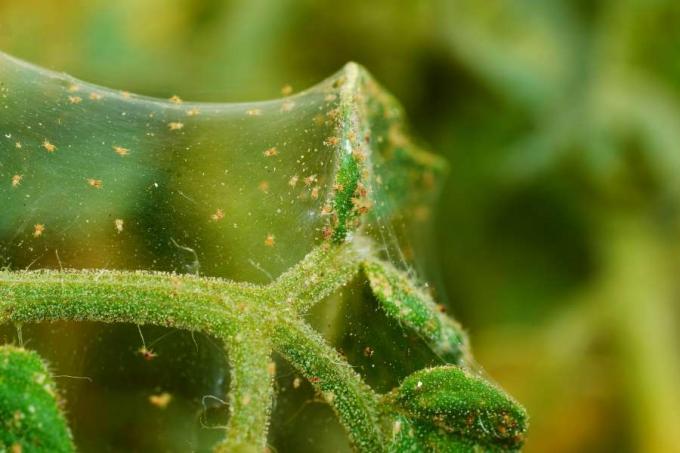
Control spider mites on tomatoes
There are many effective home remedies to combat spider mites: In the case of a light infestation, you can remove infested parts of the plant from plants that tolerate pruning. By hosing down the plant daily with a light spray of water, you increase the humidity level for the spider mites, which will help get rid of them. You can enhance this effect by putting a transparent plastic bag over the plant. To prevent damage to the plant, we recommend carrying out this measure for a maximum of four days. We strictly advise against using a tobacco brew that is repeatedly mentioned in various guidebooks. Nicotine is a neurotoxin that is toxic to humans and its use on plants has been a criminal offense in the EU since 2001.
The use of gall midges (Cecidomyiidae) or predatory mites (Gamasina) is a way to fight spider mites with beneficial insects. Especially the predatory mites Phytoseiulus persimilis or Amblyseius californicus can be purchased on the Internet and used in a targeted manner. However, if you have decided to use beneficial insects, you should refrain from using a pesticide, as this would harm the beneficial insects.

However, spider mites can be very stubborn, which is why we recommend using a biological pesticide in the case of an advanced infestation. We advise against the use of synthetic pesticides, especially in the home garden, as these agents usually have a high potential for damage to beneficial insects. Spider mites are also already resistant to some synthetic active ingredients. Most biological pesticides against spider mites are based on rapeseed oil. The oil ensures that the pests die on direct contact. It is therefore important to wet the plant with the spray mixture on all affected areas. Several treatments are usually necessary for good effectiveness.
If you cultivate your tomatoes in a greenhouse, you can prevent the air in the greenhouse from becoming too dry. Spider mites thrive in dry air, so humidifying the air can help. We also recommend reduced nitrogen fertilization and a good supply of potassium to your plants. This makes your plants less attractive to spider mites. You can easily achieve this with a special tomato fertilizer, like ours Plantura organic tomato fertilizer.
Some more tips on the subject Identify, prevent and combat spider mites we have put together for you in our special article.
Summary: Fighting and getting rid of spider mites on tomatoes
- If possible, remove heavily infested parts of the plant
- Rinse affected plants daily with water
- Put a plastic bag over infested plants for four days
- Targeted use of gall midges or predatory mites
- Biological pesticides based on rapeseed oil
- As a preventative measure, ensure that the air in the greenhouse is not too dry
- Reduced nitrogen fertilization and good supply of potassium to your tomatoes
tomato leaf miners
tomato leaf miners (Tuta absoluta) have only been a pest in Germany for about ten years. The adult tomato miner moths are grey-brown in color and have a wingspan of up to one centimetre. The adult animals hide during the day, which is why they are usually difficult to find. An infestation by the tomato leaf miner can best be recognized by the damage to the larvae: The larvae leave speckled mining burrows in leaves and sometimes in as they feed fruits. The caterpillars are permanently located in the leaf between the upper and lower leaf skin.
Control tomato leaf miners on tomatoes
In the commercial cultivation of tomatoes, the use of the assassin bug Macrolophus pygmaeus the most common action. However, the establishment of the assassin bug is not easy and quite time-consuming. A pesticide against the tomato leaf miner is not approved in Germany. We therefore recommend preventive measures to prevent re-infestation in the following year. An effective biological measure is the nematode species before planting the tomatoes in spring Steinernema carpocapsae spread with water on the planting area. This is what we recommend when planting your tomatoes in established soil.

You should also avoid planting tomatoes in the same spot for several years in a row in the grown soil. If you plant the tomatoes in pots, you should not use the soil again to grow tomatoes. And also the optimal supply of nutrients, for example with our Plantura organic tomato fertilizer, makes the plants healthy and enables them to form effective defenses against the tomato leaf miner and other pests.
Summary: Control and prevent tomato leaf miners
- assassin bug Macrolophus pygmaeus can be used, but establishment is complicated
- nematode Steinernema carpocapsae as a preventive measure on grown soil
- No pesticides allowed
- Do not reuse potting soil when cultivating in a pot, tomatoes and other nightshades (Solanaceae) do not plant several times in a row on the same area
- Optimal plant care to keep plants defensive
Nematodes on tomatoes
Nematodes (Nematoda) are also called roundworms and occur as parasites in soil, water and living organisms. Depending on the species, the nematodes attack the flowers, leaves or roots of the tomato, but they can also be used as beneficial insects in biological plant protection. They enrich themselves by liquefying and absorbing the contents of entire cells. In addition, nematodes can also transmit viruses. An infestation is difficult to detect. Indications can be signs of wilting despite sufficient water supply, reduced growth or black discoloration at the base of the stem.
Control nematodes on tomatoes
Combating the harmful nematode species with a pesticide is not possible with tomatoes, as no agent is approved in Germany. So let's take a look at the other options:
For example, the cultivation of tagetes, especially the kind tagetes patula, help with a nematode infestation on tomatoes. The marigolds (tagetes) produces a nematicide in its root cells – i.e. a poison against nematodes. Although marigolds only help against the nematode genus Pratylenchus, but in general it is wise and helpful to include marigolds in the crop rotation, as these are not hosts for nematodes. Planting marigolds among the tomatoes is also an option, albeit with a much smaller effect.

To combat tomato-damaging nematodes, we recommend consistent crop rotation or the use of Resistant varieties such as: 'Campari', 'Dolcevita', Tropical 'Matias' and 'Piccolino' and the rootstock 'Vigomax'.
Summary: Control nematodes on tomatoes
- Tagetes as a cover crop on an area previously cultivated with tomatoes
- Do not grow tomatoes or other nightshade plants (Solanaceae) for several years in the same area
- Choose resistant tomato varieties
Preventing tomato pests: How to protect your tomatoes
In general, the best preventive measure is to provide the plants with the best possible conditions. This includes, above all, a needs-based supply of nutrients. We recommend that you ensure a good supply of potassium and moderate nitrogen fertilization. Suitable fertilizers, like ours Plantura organic tomato fertilizer, help you to optimally care for the tomato plants. A planting distance of about 70 centimeters in the grown soil reduces competition for nutrients and slows the spread of diseases or pests.
Many pests feel particularly comfortable in greenhouses. Therefore, we recommend checking the plants regularly for pests, especially in protected cultivation, in order to prevent mass propagation. Some pests also like dry air, which is why you can work preventively with a slightly higher humidity level.
In the garden, encouraging beneficial insects is another very helpful way to prevent problems with pests. We recommend that you use plant protection that is gentle on beneficial insects, for example with compatible household remedies and organic plant protection products. You can also welcome beneficial insects with breeding facilities such as an insect hotel. A flower meadow that is as untouched as possible offers beneficial insects a home in your garden. Our beneficial magnet is a seed mixture that makes it easy for you to create such a flower meadow.
A sensible one Crop rotation in tomatoes helps you not to leach the soil one-sidedly and stops the accumulation of diseases and pests from one crop year to the next. We therefore recommend that you plant another crop, such as lettuce (Lactuca sativa) or spinach (Spinacia oleracea) to plant. Plants related to the tomato, such as potatoes (Solanum tuberosum) or aubergines (Solanum melongena) should also not be grown there during this time, as they can be affected by the same diseases as tomatoes.
A heavy infestation by pests is caused by a Mixed culture of tomatoes less likely than if you plant a monoculture. With their essential oils, for example, parsley (Petroselinum crispum) and basil (Ocimum basilicum) Keep lice away from tomatoes. onions (Allium cepa), Leek (Allium ampeloprasum) and garlic (Allium sativum) are also excellent neighbors for tomatoes, since they mainly attract whiteflies (Aleyrodidae) to evict. Marigolds are a nice touch of color in the bed and help a little against root nematodes.

A mixed culture is not only useful with regard to pests. A socialization of different plants in a bed ensures a stronger shading of the soil surface. This not only protects the soil from drying out, but also suppresses weed growth. In addition, the nutrients present in the soil are used better than if only one species is planted in the bed.
Not only pests can endanger the tomato harvest. This is how they arise tomato damage also for environmental and physiological reasons. We will show you how to recognize them and how to prevent them.

